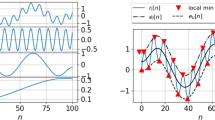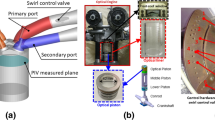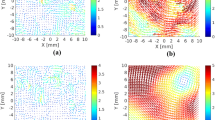Abstract
The bivariate two dimensional empirical mode decomposition (Bivariate 2D-EMD) is extended to estimate the turbulent fluctuations and to identify cycle-to-cycle variations (CCV) of in-cylinder flow. The Bivariate 2D-EMD is an adaptive approach that is not restricted by statistical convergence criterion, hence it can be used for analyzing the nonlinear and non-stationary phenomena. The methodology is applied to a high-speed PIV dataset that measures the velocity field within the tumble symmetry plane of an optically accessible engine. The instantaneous velocity field is decomposed into a finite number of 2D spatial modes. Based on energy considerations, the in-cylinder flow large-scale organized motion is separated from turbulent fluctuations. This study is focused on the second half of the compression stroke. For most of the cycles, the maximum of turbulent fluctuations is located between 50 and 30 crank angle degrees before top dead center (TDC). In regards to the phase-averaged velocity field, the contribution of CCV to the fluctuating kinetic energy is approximately 55% near TDC.





















Similar content being viewed by others
References
Abraham, P., Reuss, D., Sick, V.: High-speed particle image velocimetry study of in-cylinder flows with improved dynamic range. Tech. rep, SAE Technical Paper (2013)
Baum, E., Peterson, B., Böhm, B., Dreizler, A.: On the validation of LES applied to internal combustion engine flows: part 1: comprehensive experimental database. Flow Turbul. Combust. 92(1–2), 269–297 (2014)
Bizon, K., Continillo, G., Lombardi, S., Sementa, P., Vaglieco, B.M.: Independent component analysis of cycle resolved combustion images from a spark ignition optical engine. Combust. Flame 163, 258–269 (2016)
Borée, J., Miles, P.C.: In-Cylinder Flow. Encyclopedia of Automotive Engineering, pp. 1–31. Wiley (2014)
Cao, Y., Kaiser, E., Borée, J., Noack, B.R., Thomas, L., Guilain, S.: Cluster-based analysis of cycle-to-cycle variations: application to internal combustion engines. Exp. Fluids 55(11), 1837 (2014)
Cao, J., Ma, Z., Li, X., Xu, M.: Three dimensional proper orthogonal decomposition analysis of engine in-cylinder velocity fields. Meas. Sci. Technol. 30(8), 085304 (2019)
Chen, H., Reuss, D.L., Sick, V.: On the use and interpretation of proper orthogonal decomposition of in-cylinder engine flows. Meas. Sci. Technol. 23(8), 085302 (2012)
Clark, L.G., Kook, S.: Correlation of spatial and temporal filtering methods for turbulence quantification in spark-ignition direct-injection (sidi) engine flows. Flow Turbul. Combust. 101(1), 161–189 (2018)
Cosadia, I., Borée, J., Charnay, G., Dumont, P.: Cyclic variations of the swirling flow in a diesel transparent engine. Exp. Fluids 41(1), 115 (2006)
Dragomiretskiy, K., Zosso, D.: Variational mode decomposition. IEEE Trans. Signal Process. 62(3), 531–544 (2013)
Druault, P., Guibert, P., Alizon, F.: Use of proper orthogonal decomposition for time interpolation from PIV data. Exp. Fluids 39(6), 1009–1023 (2005)
Feynman, J., Ruzmaikin, A.: The centennial gleissberg cycle and its association with extended minima. J. Geophys. Res. Space Phys. 119(8), 6027–6041 (2014)
Fogleman, M., Rempfer, D., Lumley, J.L., Haworth, D.: POD Analysis of In-Cylinder Flows. In: ASME 2002 Joint US-European Fluids Engineering Division Conference, pp. 1173–1178. American Society of Mechanical Engineers (2002)
Fogleman, M., Lumley, J., Rempfer, D., Haworth, D.: Application of the proper orthogonal decomposition to datasets of internal combustion engine flows. J. Turbul. 5(23), 1–3 (2004)
Freudenhammer, D., Peterson, B., Ding, C.P., Boehm, B., Grundmann, S.: The influence of cylinder head geometry variations on the volumetric intake flow captured by magnetic resonance velocimetry. SAE Int. J. Eng. 8(4), 1826–1836 (2015)
Galmiche, B., Mazellier, N., Halter, F., Foucher, F.: Turbulence characterization of a high-pressure high-temperature fan-stirred combustion vessel using LDV, PIV and TR-PIV measurements. Exp. Fluids 55(1), 1636 (2014)
Gosman, A.: Flow processes in cylinders. Thermodyn. Gas Dyn. Intern. Combust. Eng. 2, 616–772 (1986)
Graftieaux, L., Michard, M., Grosjean, N.: Combining PIV, POD and vortex identification algorithms for the study of unsteady turbulent swirling flows. Meas. Sci. Technol. 12(9), 1422 (2001)
Heim, D.M., Jesch, D., Ghandhi, J.B.: Size-scaling effect on the velocity field of an internal combustion engine, part ii: turbulence characteristics. Int. J. Eng. Res. 15(2), 193–208 (2014)
Hemakom, A., Goverdovsky, V., Looney, D., Mandic, D.P.: Adaptive-projection intrinsically transformed multivariate empirical mode decomposition in cooperative brain-computer interface applications. Phil. Trans. R. Soc. A 374(2065), 20150199 (2016)
Heywood, J.B.: Internal Combustion Engine Fundamentals. McGraw-Hill, New York (1988)
Huang, N.E., Shen, Z., Long, S.R., Wu, M.C., Shih, H.H., Zheng, Q., Yen, N.C., Tung, C.C., Liu, H.H.: The empirical mode decomposition and the Hilbert spectrum for nonlinear and non-stationary time series analysis. Proc. R. Soc. Lond. Ser. A: Math. Phys. Eng. Sci. 454(1971), 903–995 (1998)
Huang, N.E., Shen, Z., Long, S.R.: A new view of nonlinear water waves: the Hilbert spectrum. Annu. Rev. Fluid Mech. 31(1), 417–457 (1999)
Huang, Y.X., Schmitt, F.G., Lu, Z.M., Liu, Y.L.: An amplitude-frequency study of turbulent scaling intermittency using empirical mode decomposition and Hilbert spectral analysis. EPL (Europhys. Lett.) 84(4), 40010 (2008)
Janas, P., Wlokas, I., Böhm, B., Kempf, A.: On the evolution of the flow field in a spark ignition engine. Flow Turbul. Combust. 98(1), 237–264 (2017)
Kaneko, M., Ikeda, Y., Nakajima, T.: Tumble generator valve (TGV) control of in-cylinder bulk flow and its turbulence near spark plug in si engine. SAE Transactions pp. 1635–1643 (2001)
Kapitza, L., Imberdis, O., Bensler, H., Willand, J., Thévenin, D.: An experimental analysis of the turbulent structures generated by the intake port of a DISI-engine. Exp. Fluids 48(2), 265–280 (2010)
Lumley, J.: The structure of inhomogeneous turbulence, atmospheric turbulence and wave propagation. AM Yaglom, VI Tatarski, pp. 166–178 (1967)
Lumley, J.L.: Engines: An Introduction. Cambridge University Press, Cambridge (1999)
Lumley, J.L.: Early work on fluid mechanics in the IC engine. Annu. Rev. Fluid Mech. 33(1), 319–338 (2001)
Marc, D., Borée, J., Bazile, R., Charnay, G.: Tumbling vortex flow in a model square piston compression machine: PIV and LDV measurements. Tech. rep, SAE Technical Paper (1997)
Müller, S., Böhm, B., Gleißner, M., Grzeszik, R., Arndt, S., Dreizler, A.: Flow field measurements in an optically accessible, direct-injection spray-guided internal combustion engine using high-speed PIV. Exp. Fluids 48(2), 281–290 (2010)
Ozdor, N., Dulger, M., Sher, E.: Cyclic variability in spark ignition engines a literature survey. SAE transactions pp. 1514–1552 (1994)
Peterson, B., Baum, E., Böhm, B., Sick, V., Dreizler, A.: High-speed piv and lif imaging of temperature stratification in an internal combustion engine. Proc. Combust. Inst. 34(2), 3653–3660 (2013)
Pope, S.B.: Turbulent Flows. Cambridge University Press, Cambridge (2000)
Qian, C., Wu, Z., Fu, C., Wang, D.: On changing El Niño: a view from time-varying annual cycle, interannual variability, and mean state. J. Clim. 24(24), 6486–6500 (2011)
Rehman, N., Park, C., Huang, N.E., Mandic, D.P.: EMD via MEMD: multivariate noise-aided computation of standard EMD. Adv. Adapt. Data Anal. 5(02), 1350007 (2013)
Reuss, D.L.: Cyclic variability of large-scale turbulent structures in directed and undirected ic engine flows. SAE transactions pp. 128–145 (2000)
Rothrock, A.M., Spencer, R.C.: The influence of Directed Air Flow on Combustion in Spark-Ignition Engine. US Government Printing Office, Washington, DC (1939)
Roudnitzky, S., Druault, P., Guibert, P.: Proper orthogonal decomposition of in-cylinder engine flow into mean component, coherent structures and random Gaussian fluctuations. J. Turbul. 7, N70 (2006)
Sadeghi, M., Foucher, F., Abed-Meraim, K., Mounaïm-Rousselle, C.: Bivariate 2D Empirical mode decomposition for analyzing instantaneous turbulent velocity field in unsteady flows. Exp. Fluids 60(8), 131 (2019)
Sakowitz, A., Mihaescu, M., Fuchs, L.: Flow decomposition methods applied to the flow in an ic engine manifold. Appl. Therm. Eng. 65(1–2), 57–65 (2014)
Schmid, P.J.: Dynamic mode decomposition of numerical and experimental data. J. Fluid Mech. 656, 5–28 (2010)
Sullivan, P., Ancimer, R., Wallace, J.: Turbulence averaging within spark ignition engines. Exp. Fluids 27(1), 92–101 (1999)
Ur Rehman, N., Mandic, D.P.: Filter bank property of multivariate empirical mode decomposition. IEEE Trans. Signal Process. 59(5), 2421–2426 (2011)
Voisine, M., Thomas, L., Borée, J., Rey, P.: Spatio-temporal structure and cycle to cycle variations of an in-cylinder tumbling flow. Exp. Fluids 50(5), 1393–1407 (2011)
Wang, G., Chen, X.Y., Qiao, F.L., Wu, Z., Huang, N.E.: On intrinsic mode function. Adv. Adapt. Data Anal. 2(03), 277–293 (2010)
Wiktorsson, M., Lindoff, B., Johansson, B., Soderberg, F.: Wavelet analysis of in-cylinder LDV velocity measurements. Tech. rep, SAE Technical Paper (1996)
Wu, Z., Huang, N.E., Chen, X.: The multi-dimensional ensemble empirical mode decomposition method. Adv. Adapt. Data Anal. 1, 339–372 (2009)
Wu, C.H., Chang, H.C., Lee, P.L., Li, K.S., Sie, J.J., Sun, C.W., Yang, C., Li, P.H., Deng, H.T., Shyu, K.K.: Frequency recognition in an SSVEP-based brain computer interface using empirical mode decomposition and refined generalized zero-crossing. J. Neurosci. Methods 196(1), 170–181 (2011)
Yamakawa, M., Youso, T., Fujikawa, T., Nishimoto, T., Wada, Y., Sato, K., Yokohata, H.: Combustion technology development for a high compression ratio SI engine. SAE Int. J. Fuels Lubr. 5(1), 98–105 (2012)
Zentgraf, F., Baum, E., Böhm, B., Dreizler, A., Peterson, B.: On the turbulent flow in piston engines: coupling of statistical theory quantities and instantaneous turbulence. Phys. Fluids 28(4), 045108 (2016)
Acknowledgements
The authors would like to express their gratitude to Pr. Jacques Borée (Institut Pprime, CNRS, Univ. Poitiers – ENSMA), Pr. Karim Abed-Meraim (Prisme Laboratory, Univ. Orléans) and Dr. Laurent Duval (IFPEN, Rueil-Malmaison) for enriching discussions. Benjamin Böhm kindly acknowledges generous support by Deutsche Forschungsgemeinschaft through FOR 2687 “Cyclic variations in highly optimized spark-ignition engines: experiment and simulation of a multi-scale causal chain”—Project Number 423224402. Brian Peterson kindly acknowledges financial support by the European Research Council (ERC, Grant No. 759546).
Author information
Authors and Affiliations
Corresponding author
Ethics declarations
Conflict of interest
The authors declare that they have no competing interests.
Appendix
Appendix
A synthetic Lamb–Oseen vortex, \(\text {U}_{i}(x,y)\) that mimics large-scale organized motion is perturbed by an experimental HIT velocity field, \(\text {P}(x,y)\) within \(127 \times 127\) data points with spatial resolution of 0.16 mm (Galmiche et al. 2014), shown in Fig. 22a and b, respectively. The HIT flow has a longitudinal integral length-scale of 3.2 mm and the scale of vortex is approximately five times larger. The primary perturbed velocity field in Fig. 22c is interpolated on \(254 \times 254\) data points with spatial resolution of 0.08 mm, as presented in Fig. 22d.
The primary and interpolated velocity fields are decomposed by Bivariate 2D-EMD. The modes corresponding to the horizontal velocity components, U are shown in Fig. 23. As one can see the interpolated velocity field has one mode more than the primary field, however the last modes of both fields are quite similar. Also the 5-th mode of the primary perturbed velocity field corresponds to the 6-th mode of the interpolated one and so on up to the first mode of the primary field that is distributed on the first and second modes of the interpolated velocity field.
Figure 24 presents the energy content of each mode for two decomposed velocity fields in logarithmic scale. For both cases, a significant increase in the energy of last mode is observed. This mode is considered as the organized motion (\({\mathbf {U}}_{\mathbf {Lf}}\)) and the sum of the other modes represents the HIT velocity field (\({\mathbf {U}}_{\mathbf {Hf}}\)). These flow fields are illustrated in the first and second row of Fig. 25 for the primary and interpolated velocity field, respectively. By observation, there is a good agreement between the flow structures of two Hf velocity fields as well as two Lf ones. Moreover the relative mean square error between mean kinetic energy of the Hf velocity fields is 6.7% and that of the Lf velocity fields is 0.3%.
As a conclusion, the interpolation of the velocity field on the grid points with higher spatial resolution affects slightly the feature of the low order modes that contain highest spatial frequency. Indeed the first mode of the primary perturbed velocity field, that can be considered as a measurement error or incoherent noise, is distributed on the first and second modes of the interpolated velocity field. However, it has no influence on the higher order modes, in particular the last one that represents the flow large-scale organized motion i.e., Lf part of the flow.
a, b Flow Lf and Hf velocity field, respectively correspond to the primary perturbed velocity field. Every four vectors are displayed, c, d flow Lf and Hf velocity field, respectively correspond to the interpolated perturbed velocity field. Every eight vectors are displayed, the unit is \(\hbox {m.s}^{-1}\)
Rights and permissions
About this article
Cite this article
Sadeghi, M., Truffin, K., Peterson, B. et al. Development and Application of Bivariate 2D-EMD for the Analysis of Instantaneous Flow Structures and Cycle-to-Cycle Variations of In-cylinder Flow. Flow Turbulence Combust 106, 231–259 (2021). https://doi.org/10.1007/s10494-020-00197-z
Received:
Accepted:
Published:
Issue Date:
DOI: https://doi.org/10.1007/s10494-020-00197-z









